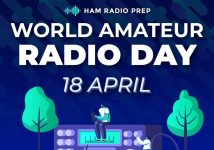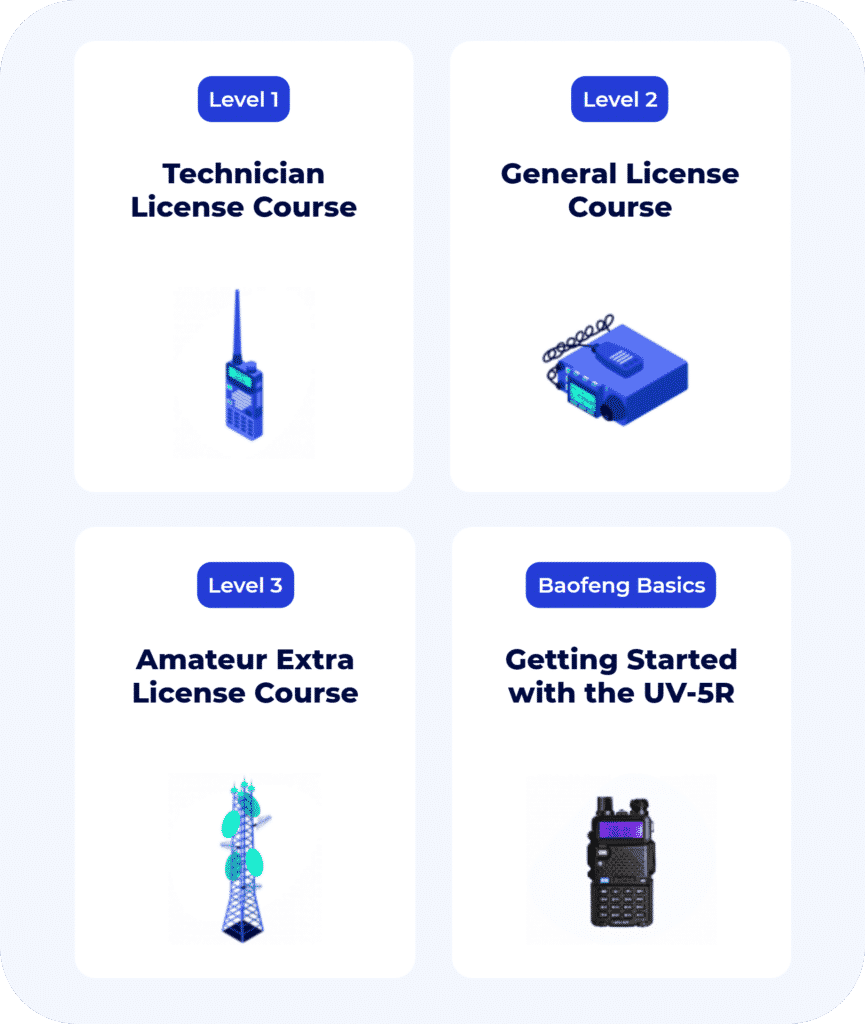In today’s world, staying connected and communicating effectively is more important than ever. Whether you’re an outdoor enthusiast, a prepper, or simply someone who wants a reliable means of communication, you may have come across both Ham Radio and GMRS (General Mobile Radio Service) as potential options.
Ham Radio, also known as amateur radio, is a popular choice among hobbyists, emergency responders, and those looking to connect with a global community of operators. On the other hand, GMRS is a land-mobile FM UHF radio service that caters to families and small groups looking for short-range communication.
By understanding the differences between Ham Radio and GMRS, you can make an informed decision about which communication system best suits your needs and preferences.
What is Ham Radio?

Ham Radio is officially known as amateur radio. It is a licensed and regulated form of wireless communication that allows users to communicate with each other locally, nationally, or even internationally. The reason for the term “amateur” is they are all unpaid volunteers.
Ham radio operators use various types of radio equipment to connect with fellow users for both recreational and emergency purposes. The amateur radio community is known for its ability to provide vital communication services during disasters and emergencies when traditional communication networks may be compromised.
Ham Radio Bands and Frequencies
Ham radio operators have access to a wide range of frequencies, including high frequency (HF), very high frequency (VHF), and ultra-high frequency (UHF) bands. Each band has its unique characteristics and propagation properties, allowing operators to communicate over short or long distances, depending on the specific band and operating conditions.
Some of the most popular ham bands include:
| Band Name | Frequency Range | Band Type |
| 2 meters | 144-148 MHz | VHF |
| 70 centimeters | 420-450 MHz | UHF |
| 20 meters | 14-14.35 MHz | HF |
Disclaimer: Please note that these are some of the popular ham radio bands, and actual frequency allocations may vary slightly by country or region. Also, some of these bands may be limited to specific types of communication or have restrictions based on the operator’s license class. See all the ham radio band plans here.
Ham Radio Licensing Levels and Privileges
In the United States, the Federal Communications Commission (FCC) requires individuals to obtain a license to operate on amateur radio frequencies.
There are three levels of licenses available: Technician, General, and Amateur Extra Class. Each license level grants the operator specific privileges and access to additional frequency bands.
- Technician Class: This entry-level license is the most common among new ham radio operators. It grants access to VHF and UHF bands, allowing for local and regional communication. To obtain a Technician Class license, you must pass a 35-question multiple-choice exam.
- General Class: The General Class license expands the operator’s privileges, providing access to HF bands for long-distance communication. To upgrade to a General Class license, you must pass a 35-question multiple-choice exam in addition to holding a Technician Class license.
- Amateur Extra Class: The Amateur Extra Class license is the highest level of licensing and offers the most privileges, including access to all available amateur radio frequencies. To obtain an Extra Class license, you must pass a 50-question multiple-choice exam and already hold a General Class license.
You can study with Ham Radio Prep’s License Courses to pass your licensing exam fast with video and text lessons and more.
Each license level requires the operator to have a solid understanding of radio theory, regulations, and operating procedures. You can get your ham radio license easily and get on the air!
What is GMRS?
General Mobile Radio Service (GMRS) is a licensed radio service in the United States that operates in the VHF and UHF bands. GMRS was initially designed for business and personal use, allowing communication between mobile, handheld, and base station radios.
Today, GMRS is popular among outdoor enthusiasts, off-roaders, and families for short-range communications in areas where cell phone coverage may be limited or unavailable.
GMRS Channels and Frequencies
| Channel Range | FRS Power | FRS Bandwidth | GMRS Power | GMRS Bandwidth |
| 1 to 7 462.5625 MHz – 462.7125 MHz |
2 Watts | 12.5 kHz | 5 Watts | 20 kHz |
| 8-14 467.5625 MHz – 467.7125 MHz |
0.5 Watts | 12.5 kHz | 0.5 Watts | 12.5 kHz |
| 15-22 462.550 MHz – 462.725 MHz |
2 Watts | 12.5 kHz | 50 Watts | 20 kHz |
| GMRS Repeater Inputs 467.550 MHz – 467.725 MHz |
N/A | N/A | 50 Watts | 20 kHz |
GMRS operates on 30 specific channels, 22 of which are shared with the Family Radio Service (FRS). The frequency range for GMRS includes both VHF and UHF bands, with frequencies between 462 MHz and 467 MHz.
These channels are divided as follows:
- Channels 1-7: FRS 2 Watts / GMRS 5 Watts (462.5625 MHz to 462.7125 MHz)
- Channels 8-14: FRS and GMRS Low power (0.5 Watts) (467.5625 MHz to 467.7125 MHz)
- Channels 15-22: FRS 2 Watts / GMRS 50 Watts (462.550 MHz to 462.725 MHz)
- Channels 23-30: GMRS repeater input channels (467.550 MHz to 467.725 MHz)
Channels with the 20 kHz higher bandwidth can send a higher quality voice signal than an 12.5 kHz signal which may have less fidelity but should still be clear.
GMRS Licensing and Privileges
To operate on GMRS channels, individuals need to obtain a GMRS license from the Federal Communications Commission (FCC). The license covers the licensee and their immediate family members, and it is valid for ten years. No exam is required to obtain a GMRS license, but there is a fee associated with the application. You can learn more about the licensing process and associated costs from FCC’s website.
GMRS licensees are allowed to use higher power levels compared to FRS users, up to 50 watts on some channels. Licensees can also use GMRS repeaters, which can extend the range of their radio communications significantly.
The practicality of GMRS extends beyond just family use. As highlighted by Gary Beckstedt, founder of North Georgia GMRS, GMRS networks like the one in North Georgia can play a crucial role in emergency situations, providing a dependable communication link in areas without cellular coverage.
For instance, the Cades Cove repeater in the North Georgia network ensures connectivity even in remote locations, proving invaluable for emergency preparedness and safety.
GMRS radios and range
GMRS radios are available in various form factors, including handheld, mobile, and base station units. The range of GMRS radios depends on factors such as radio power, antenna type, and terrain. In ideal conditions, handheld GMRS radios can provide a range of 1-5 miles, while mobile and base station units can achieve ranges of 5-25 miles or more when using repeaters.
GMRS licensing structure is very family-friendly as a single GMRS license covers not just the individual but the entire family.
This makes GMRS as a practical choice for family communication, especially during outdoor adventures or in areas with unreliable cell service. The network is also a reliable choice for broader community communication, for example, the extensive coverage of the North Georgia GMRS network.
When choosing a GMRS radio, it is essential to consider the type of use and the desired range.
In 2017 the FCC opened up access beyond voice usage to allow text messaging and GPS data usage in the GMRS service.
The Differences Between Ham Radio and GMRS
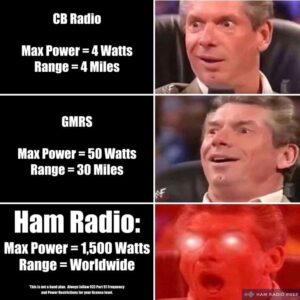
Both ham radio and GMRS are licensed services which means you must have a grant from the FCC to use them. The path to your ham radio license requires an exam after learning some basic rules and electronics information. That will give you access to a wide range of spectrum for use.
The path to a GMRS license is completing an application form at the FCC’s website. GMRS requires no exam. You will receive a call sign and license to operate on the 22 allocated GMRS channels for you and your family.
Ham radio has a larger and usually more technical community. GMRS focuses on local, family-oriented communication using a narrow set of channels with a shorter range.
| Ham Radio | GMRS | |
| License Requirements | Requires passing an exam, various license classes available | No exam required, a single license covers entire family |
| Communication Range & Capabilities | Access to VHF and UHF bands, longer range with repeaters and digital modes | Access to UHF bands, shorter range compared to ham radio |
| Equipment and Costs | Wide range of equipment, costs vary from affordable to expensive.
Hams can build or modify their equipment. |
Generally less expensive equipment, license fee required
Type approved equipment only. |
| Frequencies | Access to 420-450 MHz including simplex, repeater and non FM operating modes.
Additionally, access to multiple bands (e.g., HF, VHF, UHF, microwave) |
Access to 22 channels in the 462 MHz and 467 MHz range. FM or text message only. |
| Power Limits | Vary by frequency and license class (e.g., up to 1,500 watts for HF) | Up to 50 watts for mobile/base stations, up to 2 watts for handheld radios |
License Requirements for GMRS and Amateur Radio
Ham radio operators are required to obtain a license from the Federal Communications Commission (FCC) to ensure they have the necessary technical knowledge to operate radios safely and responsibly. The licensing process involves passing an exam, and there are three levels of licenses available: Technician, General, and Extra. Each level grants additional operating privileges on different bands and frequencies. The current license fee for a new ham is $35 for 10 years.
GMRS license covers the entire family. Unlike ham radio licenses, GMRS licenses do not require an exam. A single GMRS license covers the licensee and their immediate family members, allowing them to communicate on GMRS channels. The license is valid for ten years, and there is a fee associated with the application. The current fee for a new GMRS license is $35.
Communication Range and Frequencies
UHF Bands
Both ham radio and GMRS operate in the UHF bands. Ham radio operators have access to a broader range of frequencies (420-450 MHz), GMRS users have a more limited selection of channels (462 & 467 MHz). However, both services offer reliable communication options for various purposes and situations.
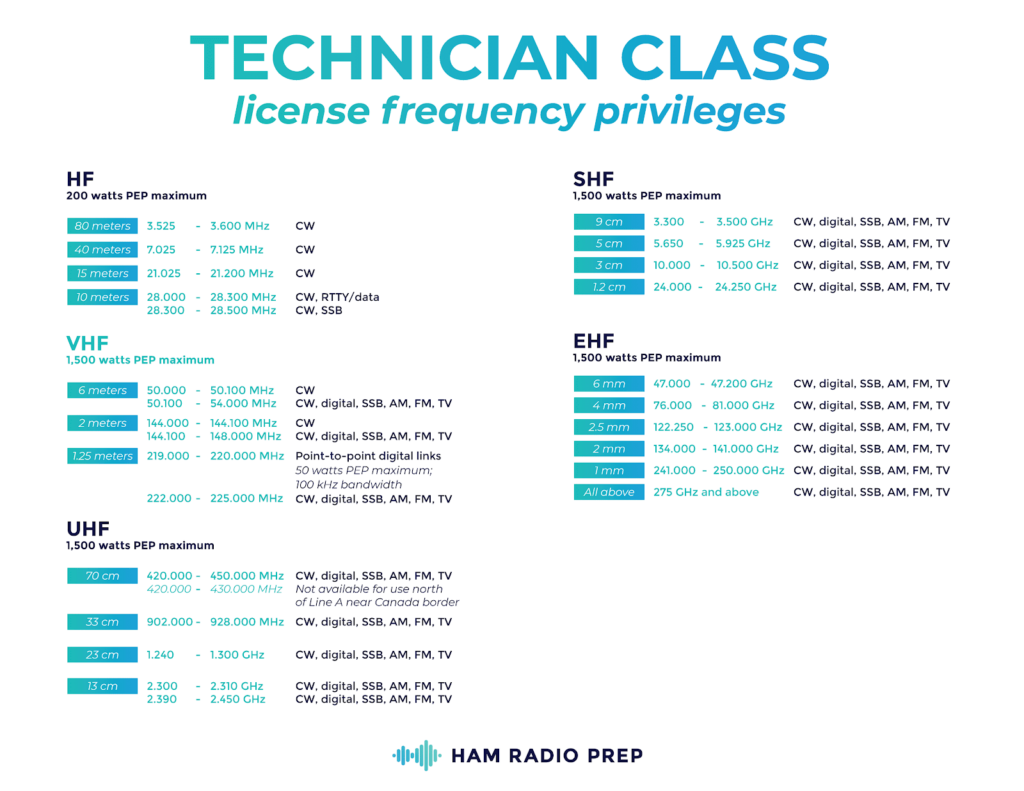
Ham Radio Repeaters vs GMRS Repeaters
Repeaters are used in both ham radio and GMRS to extend the range of radio communications. They are placed on tops of buildings or hilltops to enable communications over a wider area. If you are on the other side of a city or county, a repeater allows you to talk across the entire area. Ham and GMRS repeaters can be found throughout the country, maintained by local clubs and organizations.

This example shows a truck with a radio sending their signal to a repeater on on frequency and having it shared out or “repeated” on another.
There are thousands of ham radio repeaters in the US. In California alone there are more than 1,200 repeaters used in the 420-450 MHz range. Some of these are used for local analog talk, some are enhanced for digital communications through the Internet around the world. There is a good chance you are near coverage of a ham radio repeater in this scenario.
GMRS repeaters are also available for use by licensed operators. There are a little more than 700 GMRS Repeaters in the US, and only 38 in California. Deep diving into the state of Georgia, there are 9 GMRS repeaters, 4 are “open” meaning for anyone’s use. The other 5 are “closed” meaning you may need to be a member of a club or group to be able to access. This makes it more difficult to access a GMRS repeater if you need it. You could be out of range or trying to use a “closed” system.
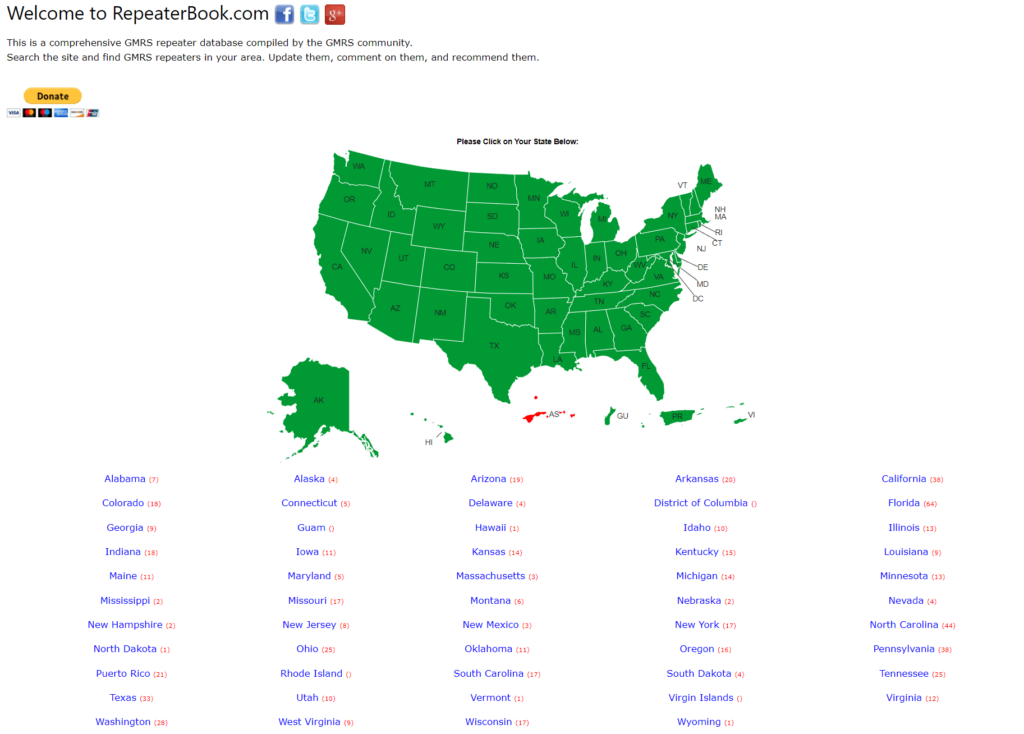
The range of ham radio communications can vary greatly depending on factors such as power output, antenna type, and propagation conditions. Generally, ham radio operators can achieve long-distance communication using various techniques and equipment, making it a versatile and powerful communication tool.
You can do more with Ham Radio!
Putting aside the technical advantages of ham radio, the amateur radio community is a diverse group of people who are passionate, with many dedicating their time and expertise to various activities within the hobby.
Some of the most fun activities for hams around the world are:
Emergency communications
Ham radio operators play a crucial role during emergencies and natural disasters, providing essential communication services when other systems fail. They work closely with organizations like the Amateur Radio Emergency Service (ARES) and the Radio Amateur Civil Emergency Service (RACES) to coordinate and relay information in times of crisis.
Contesting
Many amateur radio operators enjoy participating in contests, which are organized events where operators compete to make as many contacts as possible within a specified time frame. These contests often focus on specific bands or modes of operation and can be both a fun challenge and a great way to improve your operating skills.
DXing
DXing is the pursuit of making long-distance contacts, often with operators in other countries or remote locations. Ham radio operators engage in DXing to test their equipment, experiment with different propagation modes, and collect QSL cards, which are postcard-sized confirmations of contact between two operators.
Here are some fancy HF radios for DXers.
Satellite communication

Some ham radio operators use amateur radio satellites to communicate with other operators around the world. These satellites are launched and maintained by organizations like AMSAT, which provides a unique and exciting opportunity for operators to explore space-based communication.
Ham radio is also active on the International Space Station. Using the repeaters on the ISS lets you make contacts up to 2,000 miles away and you might just get to talk to an astronaut in their free time. Satellite communications is another area that is included in the Technician level license for ham that does not come with GMRS.
Joining Amateur Radio Clubs

Ham radio clubs and organizations provide a great way for operators to connect with like-minded individuals, share knowledge, and participate in group activities. These clubs often organize events such as field days, presentations, and license exam sessions.
Experimentation and technical innovation
The Ham Radio community has a long history of technical innovation and experimentation. Operators often build their own radio equipment, antennas, and accessories, or modify existing equipment to improve performance or add new features. This spirit of experimentation helps drive the advancement of radio technology and fosters a culture of learning and collaboration.
By participating in these activities and engaging with the wider ham radio community, amateur radio operators can develop new skills, forge lifelong friendships, and contribute to the ongoing advancement of radio technology and communication.
For more information on selecting the right radio for your needs, check out this article on the best handheld ham radios.
How to Pick Between Ham Radio and GMRS
When you’re deciding between going the GMRS route vs the ham radio route, it’s good to consider a few things.
Interestingly, GMRS often serves as a stepping stone to amateur radio. As Gary says, many GMRS users develop an interest in the more technical aspects of radio communication and eventually transition to amateur radio.
This relationship underscores the complementary nature of GMRS and ham radio, with GMRS providing an accessible entry point for families and individuals into the world of radio communications.
What’s Your Intended Use (e.g., emergency preparedness, hobbies, offroading)
When deciding between ham radio and GMRS, it’s essential to consider your intended use for the communication system. If you plan to use the radio for preparing for emergencies, ham radio is the better option due to its versatility, much higher range, and access to various communication modes.
For hobbies such as offroading or local communication with family members, GMRS can provide a simpler, user-friendly solution.
When choosing a communication system, knowing your intended use is important to find the best option for you. Here’s a closer look at how to pick the right radio service for you!
Preparing for Emergency Communication
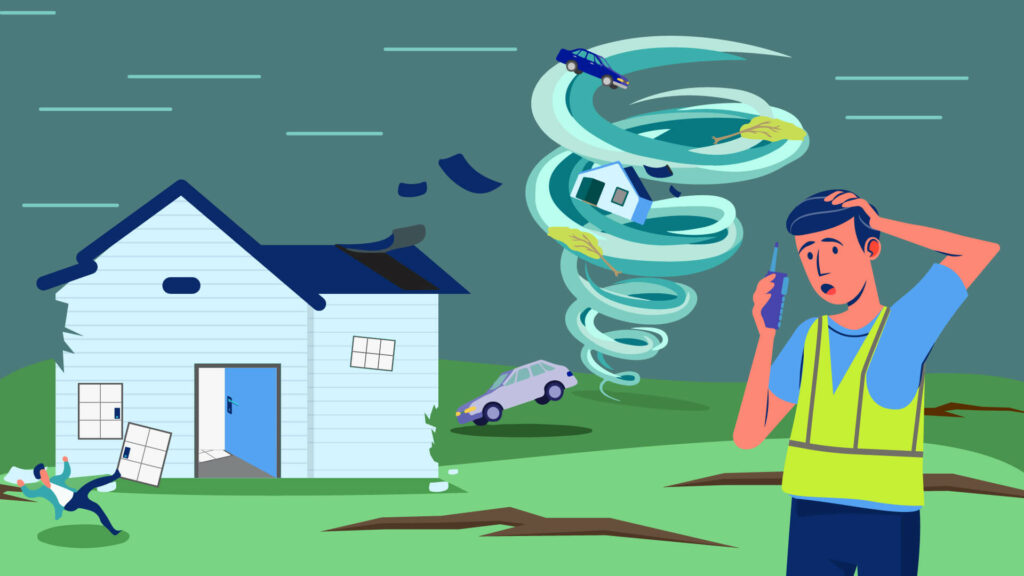
In situations where reliable communication is vital, such as during natural disasters or other emergencies, ham radio is an excellent choice. Ham radio operators have access to a wide range of frequencies and communication modes, allowing them to connect with other amateur radio operators, emergency services, and even international contacts. Additionally, the ham radio community is known for its public service and involvement in emergency communication networks and has established and well practiced groups ready for action.
Just a Hobby for Having Fun
If your primary goal is to communicate with friends or family members during recreational activities, GMRS might be a more suitable option.
With its user-friendly operation and straightforward licensing process, GMRS can be quickly set up and used for local communication. For example, offroading enthusiasts can use GMRS radios to stay in touch with other members of their group while exploring trails and navigating challenging terrain.
GMRS lower cost of entry might make it a good place to start to see if kids are interested in the radio hobby before testing them for an amateur radio license. Kids can even experiment with FRS radios, which share GMRS frequencies. A pair of radios can run less than $50 and no license is needed.

Offroading
When you’re off-grid, GMRS radios can provide the necessary communication range to stay connected with other drivers or base camp. These radios are designed for ease to use and can be mounted in vehicles or carried as handheld devices.
However, if you require more extended-range communications, ham radio is still the better choice due to its access to repeaters and a broader range of frequencies. See our detailed guide for using a ham radio for offroading.
So, that’s how you choose between ham radio and GMRS. Consider how you plan to use the radio, the range you require, and the level of complexity you’re willing to manage when making your decision.
Conclusion
After comparing Ham Radio and GMRS, you can see that both have their pros and cons. Ham Radio is more versatile and can communicate over longer distances, but it requires a license and more technical knowledge.
On the other hand, getting a GMRS license is super easy and it’s also easy to use but does have a limited range and channels.
When deciding which one to use, it really depends on your specific needs and preferences. If you are interested in emergency communication or long-distance communication, Ham Radio may be the better choice for you. If you are looking for a simple and easy-to-use radio for personal or family communication, GMRS may be the better option.
It’s also worth noting that there are other types of radios available, such as CB radio and FRS radio, that may be more suitable for certain situations. It’s important to explore and consider all other options before making a decision.
Ultimately, both Ham Radio and GMRS have their place in the world of radio communication. Whether you’re a hobbyist, a prepper, or just looking for a reliable way to communicate with others, there is a radio out there that will fit your needs.




